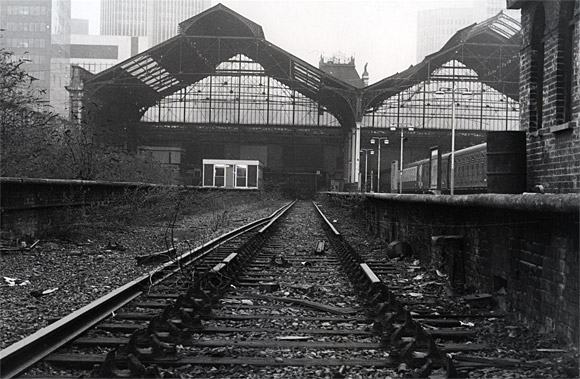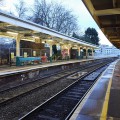
Closed in 1986 after a long and lingering death, the once bustling terminus at Broad Street was in a parlous state at the end, with its extensive canopies cut back, rails lifted and abandoned platforms sprouting weeds and small trees.
The station was built in a French Renaissance style in 1865 for the North London Railway to a design by William Baker.
Various alterations were made over the years, including the four stairways bolted on to the front, as seen in this 1898 postcard view.
Third busiest station
At the beginning of the 20th century, early Edwardian trainspotters would have been spinning with smoky excitement, watching more than one steam train per minute puffing in or out of the station.
With over 27 million passengers using the terminus in 1902, Broad Street was London’s third busiest station, with only Liverpool Street and Victoria carrying more passengers.
Decline
Competing bus, tram and Tube services hit the station hard, and major WW2 bomb damage led to the main part of the station being closed in 1950.
By the 1960s, all but two platforms remained in use, catching the eye of the evil Dr Beeching, who only failed to close the station after locals lobbied the government.
A Broad Street – Richmond train in old BR blue and grey livery waits to depart Broad Street (photo: Wikipedia).
Writing in about London’s Terminals in 1973, Sir John Betjeman painted a grim picture of the station’s plight:
In the ‘sixties, the magnificent iron roof over the train shed at Broad Street was removed. The large Lombardic buffet and the shops for City clerks were shut down, and in 1970 the scale model 4-4-0 engine, whose wheels went round if you put a penny in the slot, was either removed or stolen. Standing in the empty concourse at Broad Street today, one has a feeling of its former greatness.
A few steps back from the concourse will take you into what was once an enormous booking hall, whose timber roofs tower above the station shops. Along on the concourse now stands the 1914 War Memorial of the North London, a miniature version of the Cenotaph in Whitehall. Beyond it, incongruous and ridiculous, in red brick with pavement-light windows is a streamlined booking office for the few passengers who use this potentially popular line. May God save the Old North London!
The end
The station gamely hobbled on, but by 1985 just 6,000 passengers per week were using the station, with the morning rush hour more of a gentle saunter, with just 300 souls shuffling along its decrepit platforms.
The once-delightful station buildings were flattened in November 1985, with the site now playing host to the architecturally undistinguished Broadgate office and shopping complex.
Fact! Paul McCartney’s pretty-much-awful ‘Give My Regards to Broad Street’ film and soundtrack album was inspired by the station.


